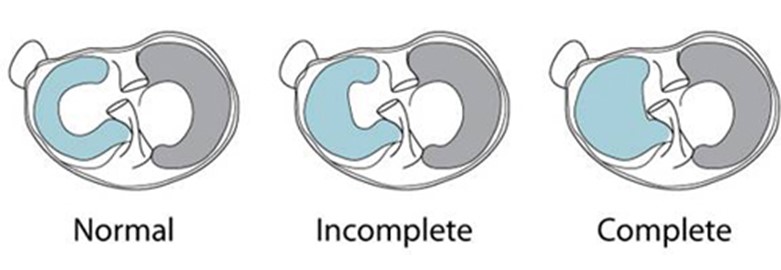Description
The meniscus is a soft piece of cartilage that acts as a shock absorber to protect the knee. There are two of these C-shaped pads in each knee and they are crescent-shaped. A
discoid meniscus is thicker than normal and has a different shape and texture. It is more likely to be injured than a normally shaped meniscus. There are people who will have a discoid meniscus and never experience an injury, but some people have problems because of it, usually during childhood. While a discoid meniscus is present from birth, injuries can occur with twisting motions to the knee, usually during pivoting motion or changes in direction while playing sports.

Drawing of the menisci in the knee, blue is lateral meniscus and gray medial meniscus. LEFT: knee has normal meniscus; MIDDLE: incomplete lateral discoid meniscus; and RIGHT: complete lateral discoid meniscu
Symptoms
Sometimes kids with a torn discoid meniscus will feel:
- Pain
- Stiffness or swelling
- Unable to fully straighten the knee
- Catching, popping, or locking of the knee
- Buckling or “giving out” of the knee
Examination
Your doctor will discuss your medical history and examine your knee. A test for a discoid meniscus involves twisting the knee with the knee bent and straight. Sometimes there is a popping or clunking feeling.
X-Rays and Tests
Your doctor will often start with x-rays. Sometimes the space between the femur (thigh bone) and tibia (lower leg bone) can appear wide on an x-ray, however x-rays do not show soft tissue very well. An MRI may be ordered to show the discoid meniscus or any tears within it.
Treatment
If the discoid meniscus is found but it is not causing any problems, treatment may not be necessary. When it is causing pain, popping, or other problems a discoid meniscus is usually treated with surgery. The orthopaedic surgeon will make a few small incisions around the knee and use a small camera and surgical instruments to treat the meniscus. These surgeries are done under anesthesia and patients are able to go home the same day.
After surgery, a knee brace or soft bandage is sometimes needed. A wheelchair or crutches may be useful for a short period of time. Physical therapy may be prescribed to regain mobility and strength following surgery.
Outcomes (Prognosis/Expectations)
If the discoid meniscus is never painful, it is possible to live with it without problems. Treatment for a painful discoid meniscus usually results in a painless knee that functions well. Children tend to do better if they are older when the symptoms begin. There is an increased risk of arthritis or another meniscus tear after an injury.
More Information
Q: What is a Discoid Meniscus?
A discoid meniscus is an abnormally shaped piece of cartilage that acts as a shock absorber in the knee between the thighbone (femur) and shinbone (tibia). There are 3 types:
- Incomplete: The meniscus is slightly thicker and wider than normal.
- Complete: The meniscus completely covers the tibia.
- Hypermobile Wrisberg: This occurs when the outer attachments of the meniscus are absent. In this case the meniscus can slip into the joint and cause pain, locking, or popping of the knee.
Q: What causes a discoid meniscus?
It is present from birth. An injury that occurs with twisting motions to the knee, often during sports, can cause it to tear.
Q: Will my child return to sports?
Many people who have a discoid meniscus never know it, because it never gets injured. A tear or injury in the meniscus can routinely be treated well enough to let most children return to sports.
Q: Is an MRI necessary?
An MRI is the best way to see a discoid meniscus. The MRI will show the abnormal shape of the discoid meniscus and any tears that might be present.
Q: Will my child need surgery?
If a discoid meniscus is not painful or causing problems, treatment may not be necessary. If it is causing problems with the knee, arthroscopic surgery is usually performed.
Q: What should I do if I suspect my child has a discoid meniscus injury?
Begin by treating the symptoms.
- Rest: Stop doing the activity that caused the injury, and give your knee plenty of time to rest. In some cases, this may involve using crutches to keep weight off your knee while it recovers.
- Ice: Apply ice or a cold compress to your knee several times a day for 15 minutes at a time until the pain and swelling go down. Wrap ice or ice packs in a towel. Don't put them directly on the skin as this can cause tissue damage.
- Compression: Use an elastic compression bandage to keep swelling down and help support your knee.
- Elevation: Lie down and put pillows under your knee to raise it above the level of your heart. This will help keep swelling to a minimum.
Have your child seen by a medical provider who can evaluate and examine the knee.

 POSNA.org
POSNA.org
